Chang-Tien Lu
Virginia Tech
Collaborative LLM Numerical Reasoning with Local Data Protection
Apr 01, 2025Abstract:Numerical reasoning over documents, which demands both contextual understanding and logical inference, is challenging for low-capacity local models deployed on computation-constrained devices. Although such complex reasoning queries could be routed to powerful remote models like GPT-4, exposing local data raises significant data leakage concerns. Existing mitigation methods generate problem descriptions or examples for remote assistance. However, the inherent complexity of numerical reasoning hinders the local model from generating logically equivalent queries and accurately inferring answers with remote guidance. In this paper, we present a model collaboration framework with two key innovations: (1) a context-aware synthesis strategy that shifts the query domains while preserving logical consistency; and (2) a tool-based answer reconstruction approach that reuses the remote-generated problem-solving pattern with code snippets. Experimental results demonstrate that our method achieves better reasoning accuracy than solely using local models while providing stronger data protection than fully relying on remote models. Furthermore, our method improves accuracy by 16.2% - 43.6% while reducing data leakage by 2.3% - 44.6% compared to existing data protection approaches.
Optimizing Product Provenance Verification using Data Valuation Methods
Feb 21, 2025Abstract:Determining and verifying product provenance remains a critical challenge in global supply chains, particularly as geopolitical conflicts and shifting borders create new incentives for misrepresentation of commodities, such as hiding the origin of illegally harvested timber or stolen agricultural products. Stable Isotope Ratio Analysis (SIRA), combined with Gaussian process regression-based isoscapes, has emerged as a powerful tool for geographic origin verification. However, the effectiveness of these models is often constrained by data scarcity and suboptimal dataset selection. In this work, we introduce a novel data valuation framework designed to enhance the selection and utilization of training data for machine learning models applied in SIRA. By prioritizing high-informative samples, our approach improves model robustness and predictive accuracy across diverse datasets and geographies. We validate our methodology with extensive experiments, demonstrating its potential to significantly enhance provenance verification, mitigate fraudulent trade practices, and strengthen regulatory enforcement of global supply chains.
Chasing the Timber Trail: Machine Learning to Reveal Harvest Location Misrepresentation
Feb 19, 2025Abstract:Illegal logging poses a significant threat to global biodiversity, climate stability, and depresses international prices for legal wood harvesting and responsible forest products trade, affecting livelihoods and communities across the globe. Stable isotope ratio analysis (SIRA) is rapidly becoming an important tool for determining the harvest location of traded, organic, products. The spatial pattern in stable isotope ratio values depends on factors such as atmospheric and environmental conditions and can thus be used for geographical identification. We present here the results of a deployed machine learning pipeline where we leverage both isotope values and atmospheric variables to determine timber harvest location. Additionally, the pipeline incorporates uncertainty estimation to facilitate the interpretation of harvest location determination for analysts. We present our experiments on a collection of oak (Quercus spp.) tree samples from its global range. Our pipeline outperforms comparable state-of-the-art models determining geographic harvest origin of commercially traded wood products, and has been used by European enforcement agencies to identify illicit Russian and Belarusian timber entering the EU market. We also identify opportunities for further advancement of our framework and how it can be generalized to help identify the origin of falsely labeled organic products throughout the supply chain.
Downscaling Precipitation with Bias-informed Conditional Diffusion Model
Dec 19, 2024

Abstract:Climate change is intensifying rainfall extremes, making high-resolution precipitation projections crucial for society to better prepare for impacts such as flooding. However, current Global Climate Models (GCMs) operate at spatial resolutions too coarse for localized analyses. To address this limitation, deep learning-based statistical downscaling methods offer promising solutions, providing high-resolution precipitation projections with a moderate computational cost. In this work, we introduce a bias-informed conditional diffusion model for statistical downscaling of precipitation. Specifically, our model leverages a conditional diffusion approach to learn distribution priors from large-scale, high-resolution precipitation datasets. The long-tail distribution of precipitation poses a unique challenge for training diffusion models; to address this, we apply gamma correction during preprocessing. Additionally, to correct biases in the downscaled results, we employ a guided-sampling strategy to enhance bias correction. Our experiments demonstrate that the proposed model achieves highly accurate results in an 8 times downscaling setting, outperforming previous deterministic methods. The code and dataset are available at https://github.com/RoseLV/research_super-resolution
Exposing LLM Vulnerabilities: Adversarial Scam Detection and Performance
Dec 01, 2024



Abstract:Can we trust Large Language Models (LLMs) to accurately predict scam? This paper investigates the vulnerabilities of LLMs when facing adversarial scam messages for the task of scam detection. We addressed this issue by creating a comprehensive dataset with fine-grained labels of scam messages, including both original and adversarial scam messages. The dataset extended traditional binary classes for the scam detection task into more nuanced scam types. Our analysis showed how adversarial examples took advantage of vulnerabilities of a LLM, leading to high misclassification rate. We evaluated the performance of LLMs on these adversarial scam messages and proposed strategies to improve their robustness.
Rethinking the Uncertainty: A Critical Review and Analysis in the Era of Large Language Models
Oct 26, 2024
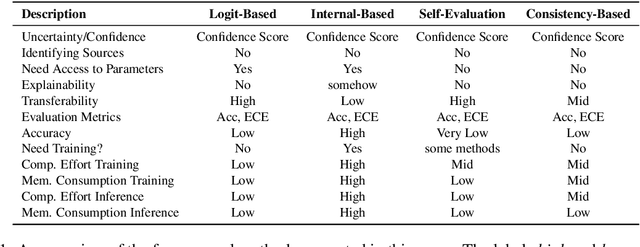
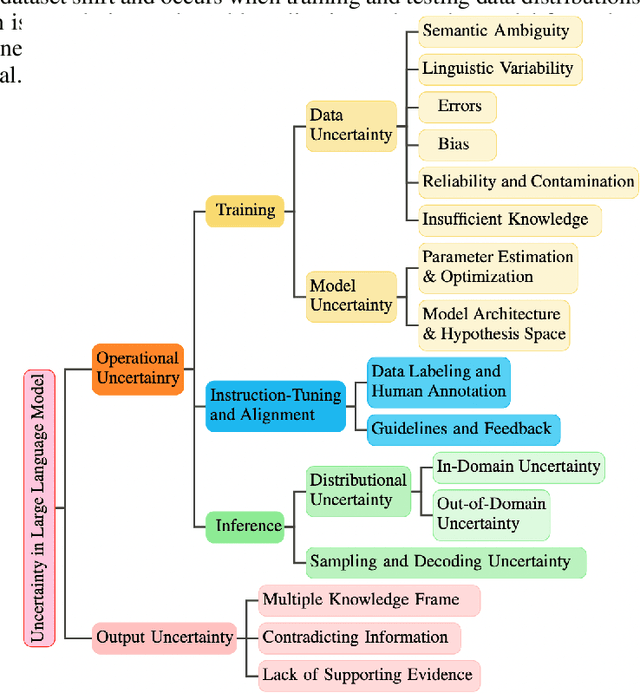
Abstract:In recent years, Large Language Models (LLMs) have become fundamental to a broad spectrum of artificial intelligence applications. As the use of LLMs expands, precisely estimating the uncertainty in their predictions has become crucial. Current methods often struggle to accurately identify, measure, and address the true uncertainty, with many focusing primarily on estimating model confidence. This discrepancy is largely due to an incomplete understanding of where, when, and how uncertainties are injected into models. This paper introduces a comprehensive framework specifically designed to identify and understand the types and sources of uncertainty, aligned with the unique characteristics of LLMs. Our framework enhances the understanding of the diverse landscape of uncertainties by systematically categorizing and defining each type, establishing a solid foundation for developing targeted methods that can precisely quantify these uncertainties. We also provide a detailed introduction to key related concepts and examine the limitations of current methods in mission-critical and safety-sensitive applications. The paper concludes with a perspective on future directions aimed at enhancing the reliability and practical adoption of these methods in real-world scenarios.
Can We Trust the Performance Evaluation of Uncertainty Estimation Methods in Text Summarization?
Jun 25, 2024Abstract:Text summarization, a key natural language generation (NLG) task, is vital in various domains. However, the high cost of inaccurate summaries in risk-critical applications, particularly those involving human-in-the-loop decision-making, raises concerns about the reliability of uncertainty estimation on text summarization (UE-TS) evaluation methods. This concern stems from the dependency of uncertainty model metrics on diverse and potentially conflicting NLG metrics. To address this issue, we introduce a comprehensive UE-TS benchmark incorporating 31 NLG metrics across four dimensions. The benchmark evaluates the uncertainty estimation capabilities of two large language models and one pre-trained language model on three datasets, with human-annotation analysis incorporated where applicable. We also assess the performance of 14 common uncertainty estimation methods within this benchmark. Our findings emphasize the importance of considering multiple uncorrelated NLG metrics and diverse uncertainty estimation methods to ensure reliable and efficient evaluation of UE-TS techniques.
InternalInspector $I^2$: Robust Confidence Estimation in LLMs through Internal States
Jun 17, 2024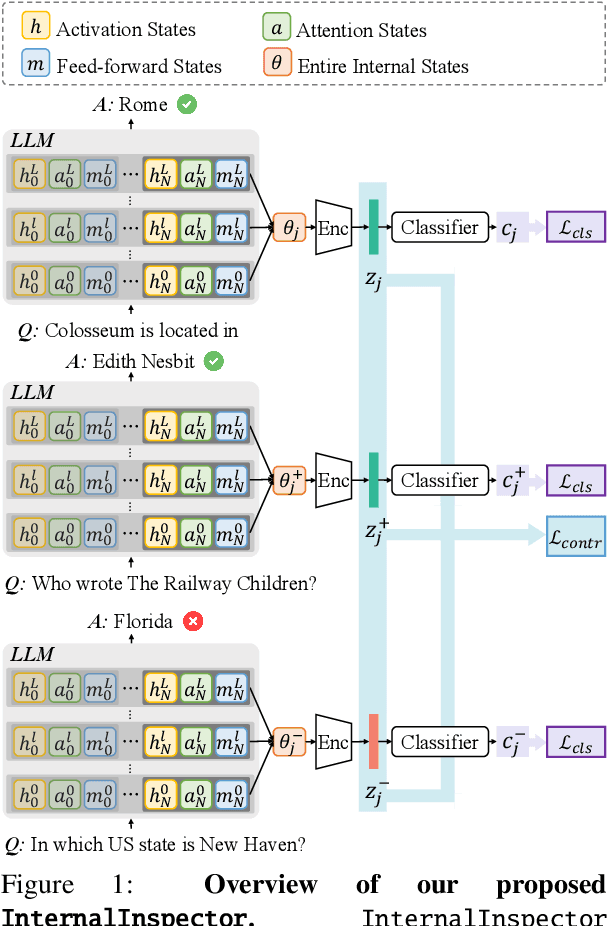
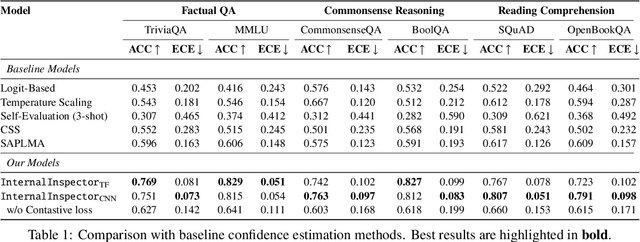
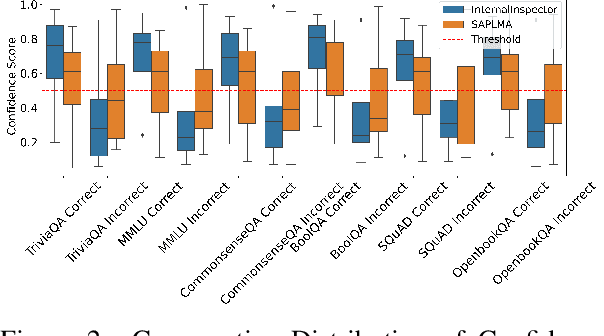
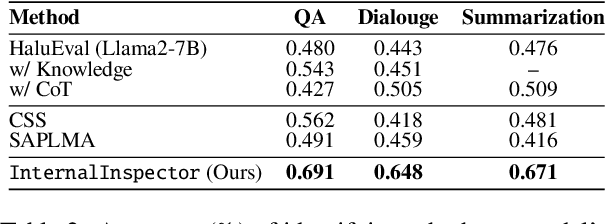
Abstract:Despite their vast capabilities, Large Language Models (LLMs) often struggle with generating reliable outputs, frequently producing high-confidence inaccuracies known as hallucinations. Addressing this challenge, our research introduces InternalInspector, a novel framework designed to enhance confidence estimation in LLMs by leveraging contrastive learning on internal states including attention states, feed-forward states, and activation states of all layers. Unlike existing methods that primarily focus on the final activation state, InternalInspector conducts a comprehensive analysis across all internal states of every layer to accurately identify both correct and incorrect prediction processes. By benchmarking InternalInspector against existing confidence estimation methods across various natural language understanding and generation tasks, including factual question answering, commonsense reasoning, and reading comprehension, InternalInspector achieves significantly higher accuracy in aligning the estimated confidence scores with the correctness of the LLM's predictions and lower calibration error. Furthermore, InternalInspector excels at HaluEval, a hallucination detection benchmark, outperforming other internal-based confidence estimation methods in this task.
DC-Gaussian: Improving 3D Gaussian Splatting for Reflective Dash Cam Videos
May 29, 2024
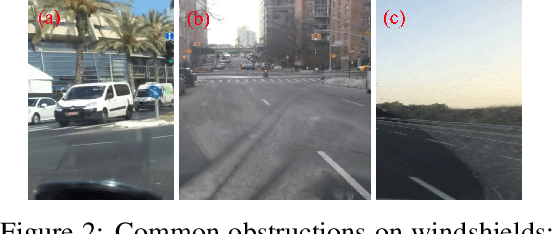
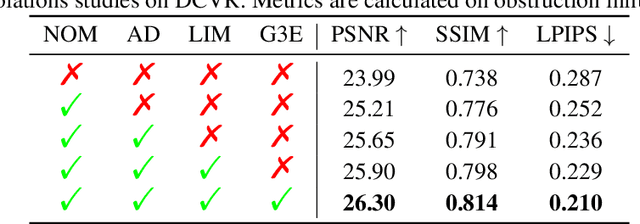
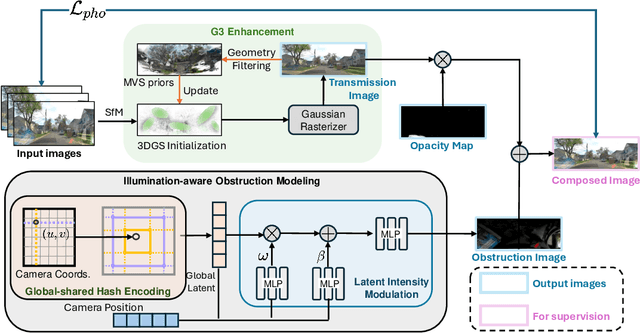
Abstract:We present DC-Gaussian, a new method for generating novel views from in-vehicle dash cam videos. While neural rendering techniques have made significant strides in driving scenarios, existing methods are primarily designed for videos collected by autonomous vehicles. However, these videos are limited in both quantity and diversity compared to dash cam videos, which are more widely used across various types of vehicles and capture a broader range of scenarios. Dash cam videos often suffer from severe obstructions such as reflections and occlusions on the windshields, which significantly impede the application of neural rendering techniques. To address this challenge, we develop DC-Gaussian based on the recent real-time neural rendering technique 3D Gaussian Splatting (3DGS). Our approach includes an adaptive image decomposition module to model reflections and occlusions in a unified manner. Additionally, we introduce illumination-aware obstruction modeling to manage reflections and occlusions under varying lighting conditions. Lastly, we employ a geometry-guided Gaussian enhancement strategy to improve rendering details by incorporating additional geometry priors. Experiments on self-captured and public dash cam videos show that our method not only achieves state-of-the-art performance in novel view synthesis, but also accurately reconstructing captured scenes getting rid of obstructions.
Network Interdiction Goes Neural
May 26, 2024Abstract:Network interdiction problems are combinatorial optimization problems involving two players: one aims to solve an optimization problem on a network, while the other seeks to modify the network to thwart the first player's objectives. Such problems typically emerge in an attacker-defender context, encompassing areas such as military operations, disease spread analysis, and communication network management. The primary bottleneck in network interdiction arises from the high time complexity of using conventional exact solvers and the challenges associated with devising efficient heuristic solvers. GNNs, recognized as a cutting-edge methodology, have shown significant effectiveness in addressing single-level CO problems on graphs, such as the traveling salesman problem, graph matching, and graph edit distance. Nevertheless, network interdiction presents a bi-level optimization challenge, which current GNNs find difficult to manage. To address this gap, we represent network interdiction problems as Mixed-Integer Linear Programming (MILP) instances, then apply a multipartite GNN with sufficient representational capacity to learn these formulations. This approach ensures that our neural network is more compatible with the mathematical algorithms designed to solve network interdiction problems, resulting in improved generalization. Through two distinct tasks, we demonstrate that our proposed method outperforms theoretical baseline models and provides advantages over traditional exact solvers.
 Add to Chrome
Add to Chrome Add to Firefox
Add to Firefox Add to Edge
Add to Edge